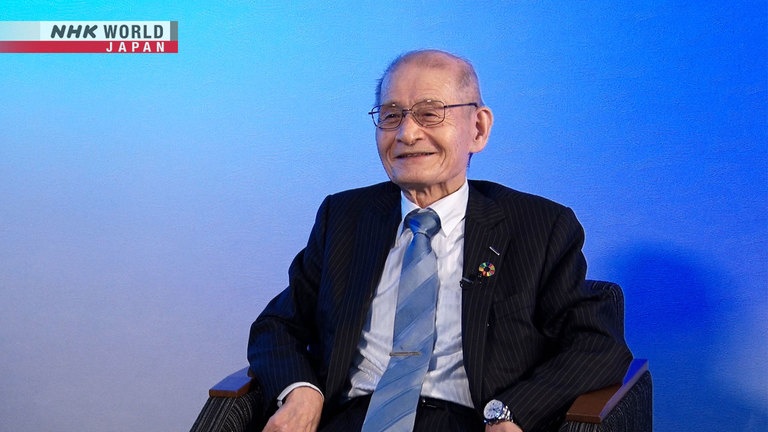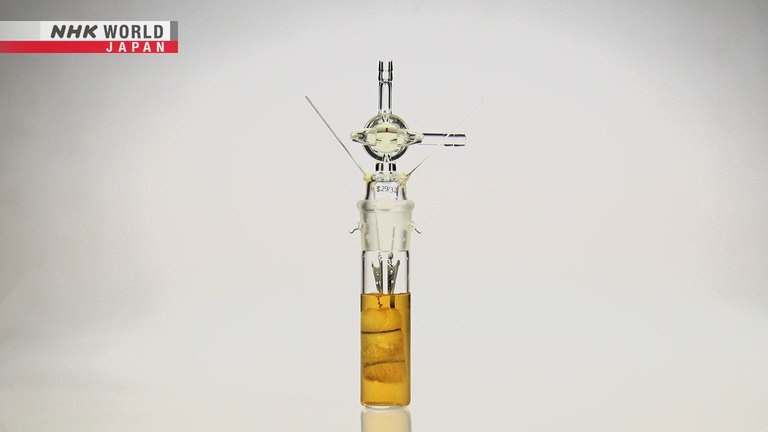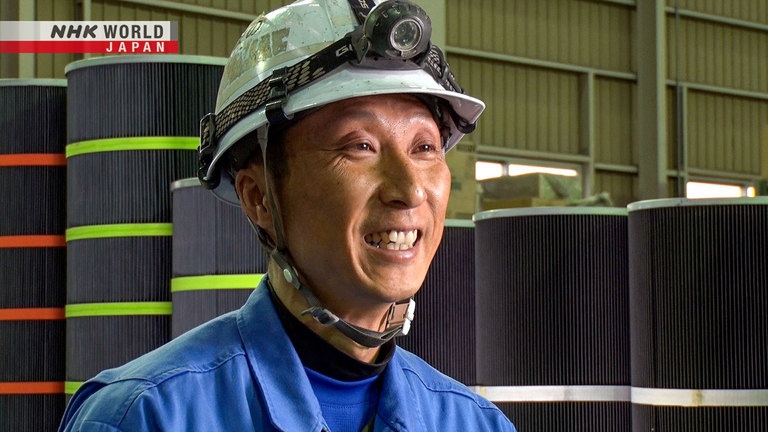Lithium-Ion Batteries / Dust Collectors for Tunnel Construction
The fascinating stories and secrets behind hit Japanese products, plus parts and machines that boast the top share of niche markets. In the first half: the story behind lithium-ion batteries, a key part of smartphones, laptops and electric vehicles. In the second half: dust collectors for tunnel construction, which help keep workers safe at worksites around the world.



Transcript
"Japan's Top Inventions"
The behind-the-scenes tales of hit products and creations from Japan.
This is "Japan's Top Inventions."
On today's show...
an essential part powering smartphones, laptops,
and electric cars.
This is what the prototype looked like. Can you guess what it is?
Later on the show...
a Japanese machine that supports tunnel construction around the world.
It's known for its high-powered suction.
We'll show you how it works.
Hello, welcome to "Japan's Top Inventions."
I'm your host, Jason Danielson.
In the first half of our show, we take you "Behind the Creation."
Today's topic is this.
They're an essential part of smartphones, laptops, and digital cameras.
Lithium-ion batteries.
These batteries are rechargeable and pack a lot of power
for being so small and light.
Lately, they're being found in more objects,
even powering electric cars.
They were invented by a Japanese engineer
who had been struggling to get his research off the ground.
The head office of a major chemical manufacturer.
Welcome.
This company is known for developing the first lithium-ion battery.
Next to the reception,
their first commercial lithium-ion battery is displayed.
Here is the prototype.
This prototype from 1983 became the basis for the battery.
It was created by an engineer at the company, Yoshino Akira.
He was awarded the Nobel Prize in Chemistry in 2019
for being one of the developers of the lithium-ion battery.
Yoshino's work was extremely innovative.
The company is very proud of his work.
Our story begins back in 1981.
A lone engineer was feeling the pressure
as he worked at a major chemical manufacturer.
Yoshino Akira, age 33.
He was responsible for basic research at the company,
with the goal of developing new business.
But not a single project he'd worked on had gone through.
He had nothing to show for his time.
Yoshino is 74 now.
He's still working as an engineer.
Here's what he remembers about those days.
Basic research doesn't have a very high success rate.
Maybe about one out of 100 projects make it to market.
Yoshino struggled in this challenging environment.
His wife, Kumiko, was a key supporter.
The two had long enjoyed playing tennis.
Playing together was a chance to forget about work for a time,
and refresh.
One day, Yoshino decided to visit his alma mater, Kyoto University,
for inspiration.
As he entered its research labs, something caught his attention.
One of the glass containers held a silver-colored substance,
a type of plastic called polyacetylene.
The appearance was totally unlike plastic.
It had a metallic shine.
That was surprising.
I didn't know plastic could shine like that.
In 1977, a Japanese researcher discovered
that polyacetylene could conduct electricity
if a small quantity of impurities was added to it.
The discovery was causing waves in the scientific community,
and many papers were being written about it.
Could polyacetylene be used for new business at the company?
Yoshino returned to work and immediately began investigating.
Yoshino gathered papers on polyacetylene, researching the new material.
He learned it had a unique property.
It could store and release ions.
The atom, the smallest unit of matter.
Atoms contain a positively charged nucleus
surrounded by negatively charged electrons.
When an atom gains or loses electrons, it becomes an ion.
Polyacetylene allowed both ions and electrons to be stored and released.
How could this property be utilized?
The first thing Yoshino thought of was a rechargeable battery.
These kinds of batteries charge and discharge as ions and electrons
move between the positive and negative ends.
A material for a battery must permit the storage and release of ions.
Polyacetylene happened to possess this quality,
so I was sure it could be used in a battery.
At that time, the world's first portable music player
had been invented in Japan.
There was growing demand for rechargeable batteries.
The competition to develop a new battery was fierce.
But companies were struggling
to create a compact and lightweight rechargeable battery.
The problem was with the lithium anode,
which was paired with a titanium disulfide cathode.
Lithium is highly flammable, so there were safety concerns.
Could polyacetylene be used for the anode instead of lithium?
Yoshino prepared some polyacetylene and an electrolyte for the battery.
He repeated tests, immersing the polyacetylene in electrolyte,
and seeing whether it worked as an anode.
Yoshino was totally committed to the tests,
going home late and exhausted each weekday.
Where did he get his energy from?
His wife Kumiko's home-cooking
provided him the sustenance to keep researching.
Her "gyoza" dumplings were delicious.
There was something with the spices.
The ginger gave it a bit of kick, woke me up. I loved it.
And so, Yoshino continued researching, day in day out.
Eventually, it was time to prototype the battery.
But there was an issue.
The anode didn't contain any lithium.
That meant the cathode had to be the one with the lithium.
The characteristics of a battery are determined
by the combination of the cathode and anode.
Even if you have a good anode, if the cathode is wrong, it won't work.
It was important to figure out what would work with polyacetylene.
What material with lithium
would be the right partner for the polyacetylene?
Yoshino was at a loss.
With polyacetylene as the material for the anode,
what would work for the cathode?
Yoshino knew that he needed something that could supply lithium ions,
but he had no leads.
However, Yoshino would soon encounter a bit of luck.
1982. It was the end of the year.
Yoshino was hard at work on the big annual cleanup at the lab.
It was then when he found it, totally by chance.
A thesis regarding rechargeable batteries.
The author was John Goodenough,
who was at the University of Oxford in England.
As he flipped through the pages, one part jumped out at him.
It stated that lithium cobalt oxide could be used as a cathode.
Goodenough, who I shared the Prize with, discovered lithium cobalt oxide.
I thought, "This is it. It's perfect."
After the cleaning that day, there was no time to experiment.
Sometimes it's when you take a breather that you hit a breakthrough.
Yoshino wasted no time working off the paper
and prototyping a battery with lithium cobalt oxide as the cathode.
But would it actually work?
Nervously, he turned it on.
The needle of the voltmeter jumped. It was discharging.
And so, in 1983, Yoshino created what would become the basis
for the lithium-ion battery, and secured a patent.
Yoshino later met with electronics and appliance manufacturers.
But he hadn't anticipated their response on these sales trips.
"Can't you make it any smaller?"
Yoshino returned to the lab and examined the options.
An issue was immediately apparent.
The polyacetylene, which had inspired development.
The plastic needed to be a certain size,
and there was a limit to how much smaller they could make it.
Yoshino would have to search again for a different material.
But he had no idea where to start.
Once again though, the key would come from somewhere unexpected.
Miyazaki, 800 kilometers away from the head office,
the company had a lab researching fibers.
They were working on a new material there. Carbon fiber.
When he looked into it,
he found that it had similar properties to polyacetylene.
It looked like I could get the same results from it.
I had a feeling, or a hope you could say,
that maybe this was it.
Yoshino gave up the polyacetylene that had kicked everything off,
and placed his hopes onto carbon fiber.
In 1985, a new battery was completed
which was a third of the previous size.
The battery had successfully been made smaller, but one issue remained.
Other companies which had also worked on lithium-ion batteries
had struggled with the flammable nature of lithium.
Was this new battery also susceptible?
Safety tests needed to be done in order to make sure it was OK.
If we failed the test, development would be scrapped.
Researchers fear this and often are tempted to skip testing.
But that's wrong. It'll always come up in the end.
It's either good or it's not. Simple as that.
Might as well face it sooner.
How could Yoshino prove the battery was safe?
The test he settled on involved dropping a large weight onto it.
Here is the experiment with other lithium batteries from then.
The battery bursts into flames on impact.
So much effort had been put into creating the new battery.
If it also caught fire like that,
it would be deemed unsafe and unfit for market.
You don't know unless you try.
The rest was out of my hands.
That's how I felt.
It was time for the drop test.
Yoshino hoped for the best as he watched over his battery.
The battery was crushed... but it didn't catch fire.
It passed.
We achieved a very high standard of safety.
With this, we'd gotten past the worst of it,
so I was extremely relieved after.
And so, the safety concerns with Yoshino's battery had been put to rest.
The batteries later went on sale in 1992.
They became used in cellphones and laptops,
quickly being found across the world.
The spread of lithium-ion batteries was boosted
by the digital revolution in the 90s.
New applications are still being found,
and they're a key part of electric vehicles today.
How do experts view this invention?
We're joined by Professor Kanno Ryoji to learn more.
Welcome to the show.
Thank you.
How has the world changed due to lithium-ion batteries?
Batteries were invented 200 years ago by Volta.
Then we had lead-acid batteries, and carbon zinc dry cells.
The advent of lithium-ion batteries led to a leap
in the energy density of batteries.
Because of this, things that couldn't run on batteries before now could.
Cars are a perfect example of this.
There's movement towards lithium-ion batteries
being the primary power source in a car.
So, our lives continue to change dramatically because of them.
What was so groundbreaking about lithium-ion batteries?
Batteries are like packing energy into a can.
There's a set shape and size,
and you try to put as much energy in there as possible.
That's where lithium-ion batteries were groundbreaking.
You're able to pack in a lot of energy.
Because of this, mobile phones have become extremely small.
Computers too. They've really made a big difference.
It's been over 30 years since Yoshino Akira developed the battery.
How have they advanced?
The capacity keeps going up and the cost keeps going down.
That's how they've been evolving.
It'd be ideal if you don't have to worry about the battery
when using a device.
Development roadmaps are being laid out in regions around the world,
and many projects are moving forward right now.
What role can Japan play in the development of new battery technology?
I think Japan's technology is top-class.
Japan's greatest strength is with lithium-ion batteries,
and it also has a lot of experience with batteries before that.
It's got the required materials and machines,
and engineers with a wide knowledge base.
If we consider all those strengths,
I think it's possible that Japan will create a new kind of battery.
That's my dream as someone who researches new battery technology.
Interesting. Thank you for your time. Nice speaking with you.
The pleasure was mine.
"Top Niche Creations."
Our next segment is "Top Niche Creations."
Today, we're looking at this.
It's a machine that plays a key role in tunnel construction.
They help protect the health of construction workers on the job.
Models made in Japan are being used at sites around the world.
Just how do they work? Let's find out!
The R&D headquarters of a machine manufacturer in the Greater Tokyo Area.
Blue machines line their lot.
These devices are shipped out
to tunnel construction sites around the world.
Hamano Kazuhiro, who leads the factory,
gave us a look at the latest model.
This is a dust collector used for tunnel construction.
It's a machine that gathers the particles created during construction.
This is real footage of a tunnel construction site.
As the tunnel is bored, the air becomes clouded with particles.
This dirt and mineral dust is about one thousandth of a millimeter big.
If it's inhaled by the workers, it can cause lung disease.
That's where this company's dust collector comes in.
Air is brought in from outside as the fan spins, sucking up the dust.
Just how strong is the machine?
Here's a demonstration using the smoke from a flare.
The smoke is sucked in right away.
At actual construction sites,
you can see how the dust is rapidly removed.
What's going on inside the machine?
We were given a special look.
That's the inside.
The machines house filter columns that are about 1.5 meters tall.
These filters are what capture the dust.
The filter material have gaps that
are only one hundredth of a micron wide.
There's also a function which prevents clogging,
which is activated with a single switch.
A large quantity of dust is automatically expelled.
Compressed air blasts through the filter,
cleaning the accumulated dust off.
As dust collects on the filter, the suction power decreases.
You can maintain power by regularly using that impulse cleaning feature.
That way, you can keep the suction power strong.
The company was originally involved in building construction.
In 1979, they began developing their dust collector.
The company was motivated at that time
by the large increase in tunnel construction workers with lung disease.
But there was a major hurdle with development.
The size of the machine.
Large filters were needed to handle all that dust,
but there wasn't enough space for a large machine in the narrow tunnels.
That's where the special pleated filters the company uses come in.
The filters have folds similar to curtains.
This allows them to take up less space
but still have large surface area.
If we compare with a standard filter that has the same capability,
you can see just how small the pleated ones are.
Using these pleated filters,
they were able to successfully create a compact dust collector.
The devices came to be used in other Asian countries too,
and places in Europe and Africa.
Later, the company used this filter technology for a new purpose.
Filtering wastewater from factories.
And factories were also interested in recovering rare metals
and other particles from the water.
They developed a system for processing water using filters.
Here is a demo setup.
An upgraded version of the pleated filters
for the dust collectors is used in here.
This black fluid is full of charcoal dust.
Let's see how the system deals with this.
There's a pump in this tank.
The water gets pumped into this,
passes through the filter, and comes back to the tank.
Five minutes later...
The water comes out clear.
There's also a machine to dry the filters
and recover the particles that were captured.
These recovered materials can then be used again and again.
Our strength lies with filter technology.
We have filters that other companies can't imitate.
It's our core business.
There's a lot of demand for filtering and recovery.
The company has recently garnered attention
for another interesting product.
This is a giant blower used to test how objects hold up in strong winds.
It's another way to make use of the fan
from their dust collector for tunnel construction.
The device tests things like the durability of home windows.
You just can't guess what they'll come up with next!
That's all for this episode of "Japan's Top Inventions."
We'll leave you with what came next
for the developer of the lithium-ion battery
from the first half of the show.
See you next time! And stay inventive.
(Yoshino Akira won the Nobel Prize in Chemistry
as one of the inventors of the lithium-ion battery.)
(He expressed his gratitude at the awards ceremony
in Stockholm with his wife Kumiko.)
(Yoshino also received an award from Kyoto,
where he had spent his university days.)
(He was presented a framed art of him playing tennis with his wife.)
(That time together helped him through difficult days.)
You have to believe that there's a goal.
If you can stick to that belief,
you'll eventually reach where you want to be.
You can overcome anything that comes at you.